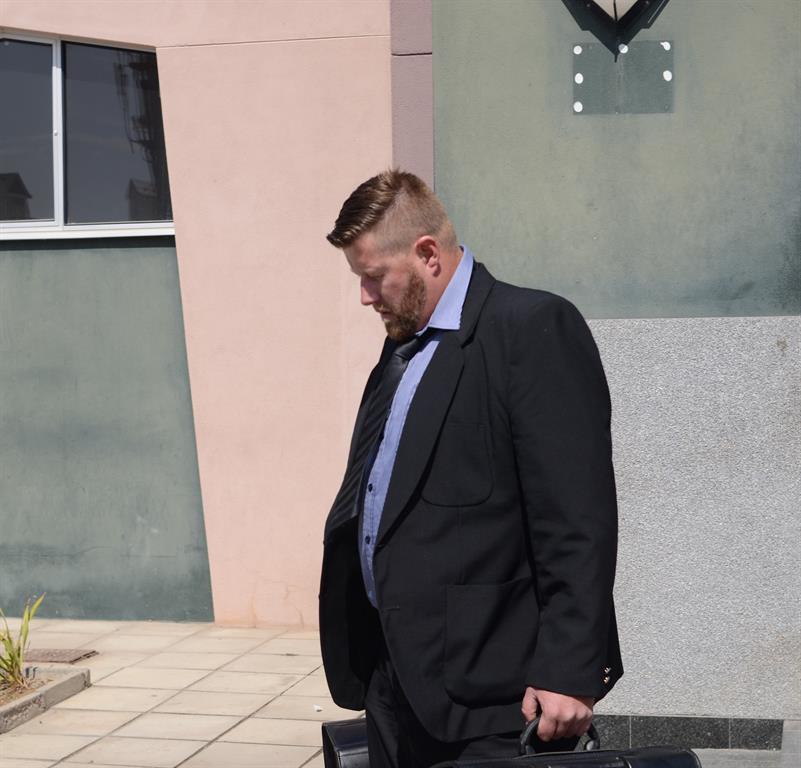Dippenaar 'was responsible'
An accident analyst has testified that Jandré Dippenaar drove at nearly 150 kilometres an hour before slamming into an oncoming bakkie, killing six people.
The horrific accident of 29 December 2014 near Henties Bay, which claimed six lives, was “caused by the driver of the Toyota FJ Cruiser”.
This incriminating statement against Jandré Dippenaar was made by accident expert Johan Joubert yesterday as the high-profile murder trial continued in the Regional Court at Swakopmund.
Joubert came to the conclusion that Dippenaar's “negligent driving” was responsible for the collision. This statement is included in Joubert's more than 100-page accident report in which he examined and checked every single detail of the collision. He did not only consider the physical evidence, but also the testimony of several witnesses.
“It's clear that the FJ Cruiser was driven at excessive speed, overtook three vehicles on a hill at a blind spot,” said Joubert.
The day before, Joubert had testified in court that he had calculated the speed of the FJ Cruiser at 147.6 km/h before the collision, while a maximum speed of 100 km/h is allowed on the salt road between Swakopmund and Henties Bay. The speed of the oncoming Ford Ranger was determined to have been 85 km/h. This figure Joubert acquired from the car's built-in GPS device.
Joubert's accident report serves as the decisive piece of evidence for the prosecution. Several witnesses have testified in the case, and most of them described Dippenaar's driving as reckless and too fast.
“From the above it is clear that the cause of the accident was in fact the reckless driving behaviour of the driver of the Toyota FJ Cruiser, Mr Jandre Dippenaar, that his reckless overtaking of three vehicles on a blind rise forced the driver of the Ford Ranger to take evasive action and as a result thereof ended up on the incorrect side (the right side of the road for vehicles travelling towards Swakopmund)”, Joubert wrote in his conclusion.
“The reckless driving behaviour of Mr Jandre Dippenaar evidently led to the death of six persons with the only surviving persons from this accident being Mr Jandre Dippenaar and Ms Antonia Joschko (sic).”
Joubert repeated his statement from the previous day that the driver of the Ford Ranger “had no other option than to swerve to the right in an attempt to avoid collision with the FJ Cruiser, as his lane was blocked by the approaching FJ Cruiser.”
Joubert's report includes several drawings of the accident scene. Dippenaar's lawyer, Louis Botes, requested a digital copy of these drawings for the defence to analyse.
“These printed drawings (A3 format) are so small that we have to play with a ruler to make our calculations. And they cannot be accurate,” said Botes.
Joubert refused to release this data and argued that the defence had appointed their own experts, who also made drawings.
Magistrate Gaynor Poulton ruled that Joubert was not required to release the files to the defence, but should print the drawings in a larger format.
The trial continues today.
ERWIN LEUSCHNER
This incriminating statement against Jandré Dippenaar was made by accident expert Johan Joubert yesterday as the high-profile murder trial continued in the Regional Court at Swakopmund.
Joubert came to the conclusion that Dippenaar's “negligent driving” was responsible for the collision. This statement is included in Joubert's more than 100-page accident report in which he examined and checked every single detail of the collision. He did not only consider the physical evidence, but also the testimony of several witnesses.
“It's clear that the FJ Cruiser was driven at excessive speed, overtook three vehicles on a hill at a blind spot,” said Joubert.
The day before, Joubert had testified in court that he had calculated the speed of the FJ Cruiser at 147.6 km/h before the collision, while a maximum speed of 100 km/h is allowed on the salt road between Swakopmund and Henties Bay. The speed of the oncoming Ford Ranger was determined to have been 85 km/h. This figure Joubert acquired from the car's built-in GPS device.
Joubert's accident report serves as the decisive piece of evidence for the prosecution. Several witnesses have testified in the case, and most of them described Dippenaar's driving as reckless and too fast.
“From the above it is clear that the cause of the accident was in fact the reckless driving behaviour of the driver of the Toyota FJ Cruiser, Mr Jandre Dippenaar, that his reckless overtaking of three vehicles on a blind rise forced the driver of the Ford Ranger to take evasive action and as a result thereof ended up on the incorrect side (the right side of the road for vehicles travelling towards Swakopmund)”, Joubert wrote in his conclusion.
“The reckless driving behaviour of Mr Jandre Dippenaar evidently led to the death of six persons with the only surviving persons from this accident being Mr Jandre Dippenaar and Ms Antonia Joschko (sic).”
Joubert repeated his statement from the previous day that the driver of the Ford Ranger “had no other option than to swerve to the right in an attempt to avoid collision with the FJ Cruiser, as his lane was blocked by the approaching FJ Cruiser.”
Joubert's report includes several drawings of the accident scene. Dippenaar's lawyer, Louis Botes, requested a digital copy of these drawings for the defence to analyse.
“These printed drawings (A3 format) are so small that we have to play with a ruler to make our calculations. And they cannot be accurate,” said Botes.
Joubert refused to release this data and argued that the defence had appointed their own experts, who also made drawings.
Magistrate Gaynor Poulton ruled that Joubert was not required to release the files to the defence, but should print the drawings in a larger format.
The trial continues today.
ERWIN LEUSCHNER




Comments
Namibian Sun
No comments have been left on this article